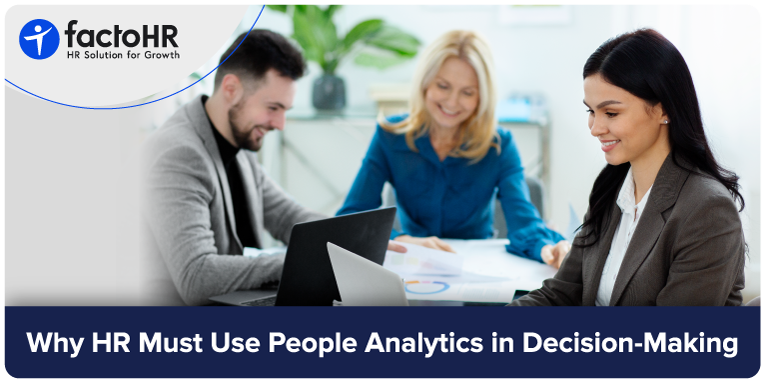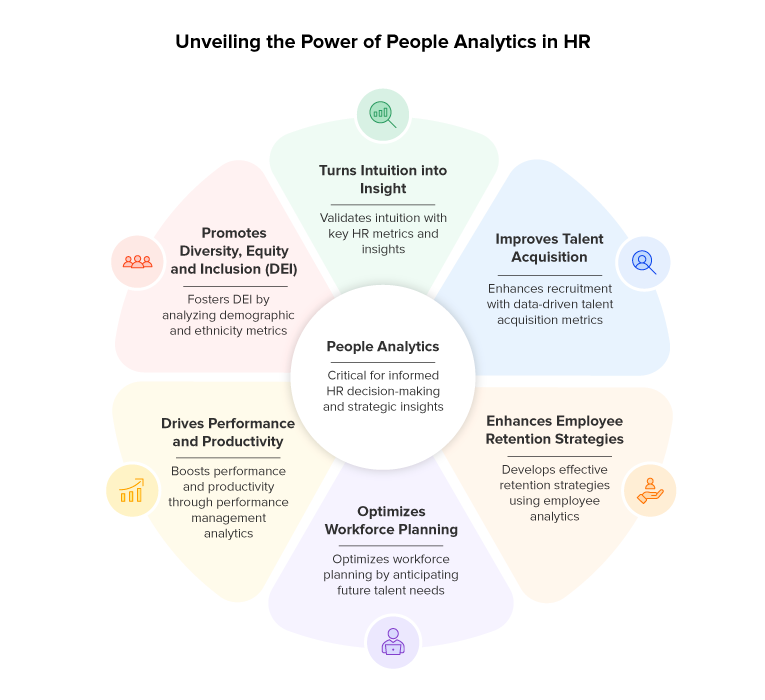People Analytics in HR: Challenges & Smarter Decision-Making

Table of Contents
Businesses are increasingly relying on data-driven decisions to optimize their workforces, hire the right talent, and outperform their competitors. This makes people analytics a crucial tool for any organization. The global people analytics in HR market is projected to be worth USD 8.98 billion. This finding is indicative of the growing importance of people analytics.
Earlier, people analytics in HR focused on improving and measuring employee productivity. Large companies such as Google, IBM, and Microsoft utilize predictive analytics to address challenges in performance management, talent acquisition, and employee retention. Now, organizations are using workforce analytics across various HR functions, including payroll processing, performance evaluation, and talent management.
This blog explains the importance of people analytics in HR and highlights their role in informed decision-making within the field.

What is People Analytics in HR?
People analytics in HR refers to gathering and analyzing people data for making data-driven decisions. People’s data includes:
- Internal data: It consists of employee performance data, metrics related to demographics, and analytics related to employee engagement.
- External data: This type of data focuses on labor market analytics, including talent availability and other relevant information.
HR managers utilize various workforce planning tools, including dashboards, self-service portals, and performance management systems, as common sources for gathering both internal and external data. For example, performance dashboards would be used to collect data related to key performance indicators (KPIs), goal achievement, employee feedback, and employee progress. Similarly, recruitment dashboards would contain relevant data related to recruitment channels and talent availability.
Why People Analytics Matter in HR Decision-Making?
People analytics are critical for decision-making for several reasons. They include real-time data from HR dashboards, which helps in making timely and accurate decisions. They also assist HR professionals in understanding the root causes of any problem, such as attrition and decreased productivity, by comparing and linking various analytics. Let’s explore the key reasons why people analytics is a must-have for any HR team.

Turns Intuition Into Insight
People analytics either confirm or reject intuition-based decisions by providing several key metrics, such as turnover rates, employee Net Promoter Score, and mobility rate. For instance, if the leadership highly rates an employee and wants to develop the individual as a future leader, then the internal mobility rate would be helpful in validating or invalidating the decision. All these metrics would be easily accessible with different HR dashboards. Similarly, you can also prevent potential workforce disruptions by accessing the absenteeism rate and related metrics.
Improves Talent Acquisition
Access to various recruitment metrics, such as time-to-hire, cost-per-hire, and conversion rate, can help HR professionals improve talent acquisition. A LinkedIn report states that over 89% of talent acquisition professionals agree that measuring the quality of new hires will become increasingly important. In such a scenario, relying on predictive HR analytics could be advantageous for organizations.
Enhances Employee Retention Strategies
Employee retention analytics, including turnover rates and flight risk scores, help HR managers develop effective employee retention strategies. Additionally, organizations can utilize employee self-service portals to conduct surveys and analyze employee sentiment. Leaders could also develop personalized skill development programs by analyzing skill gaps and other performance metrics. Such interventions would motivate employees to stay with an organization for a longer time.
Optimizes Workforce Planning
People analytics optimizes workforce planning in the following ways:
- They assist in anticipating future talent needs by interpreting internal and external data.
- They also aid in succession planning, as predictive analytics can forecast the future success of an employee based on data points such as mobility rate.
- This analytics can help identify skill gaps by comparing current competencies with the required skills.
Drives Performance and Productivity
Performance management analytics, including performance ratings, reviews, internal and external feedback, and key performance indicators (KPIs), are crucial in enhancing the performance appraisal process. Additionally, data such as absenteeism rates are essential in estimating employee productivity levels.
Promotes Diversity, Equity, and Inclusion (DEI)
HR analytics also focuses on metrics related to demographics and ethnicity. This fosters a diverse, inclusive, and equitable workforce.

What Challenges does HR Face without People Analytics?
HR managers may face several challenges, including high employee turnover, lower hiring efficiency, and increased absenteeism, among others.
- Biased decision-making: A lack of objective candidate data can lead to biased decision-making. It could also leave some room for favoritism.
- High turnover: Your organization may struggle to identify the root causes of high employee turnover without people analytics, as this tool provides access to employee retention analytics.
- Misaligned workforce planning: Lack of data-led HRMS tracking systems could make it challenging to implement workforce planning strategies, as you would not be able to analyse skill gaps, absenteeism patterns, and staff availability.
- Poor ROI from HR initiatives: Lack of practical, data-driven insights in recruitment management, talent acquisition, and performance management would result in fewer returns.
How to Start Using People Analytics in HR?
Several factors should be considered when aiming to maximize the benefits of people analytics.
- Select the right HRMS or analytics tool: Opt for an integrated core HR platform that offers features such as real-time insights, integrated dashboards, and self-service portals.
- Identify key HR metrics and KPIs: Utilize separate dashboards for tracking distinct metrics. For example, the payroll dashboard only contains metrics related to payroll and compliance, while the performance dashboard contains performance-related metrics.
- Train HR teams on data interpretation: Train your HR team and managers to use HR dashboards and interpret insights provided by analytics.
- Start small, run pilot projects: Implement HR analytics in small, experimental phases before adopting them for workforce management.

Conclusion
At a time when data is the most crucial source of truth for any organization, people analytics are essential for any business. Whether you’re a healthcare organization, an IT company, or part of the public sector, HR analytics are crucial. Data-driven performance assessments, efficient hiring processes, and employee retention strategies are some of the more notable examples that highlight the importance of people analytics.
The results of adopting analytics will be evident after 1.5 to 2 years. But you should start integrating people analytics from today!
Grow your business with factoHR today
Focus on the significant decision-making tasks, transfer all your common repetitive HR tasks to factoHR and see the things falling into their place.

© 2025 Copyright factoHR


